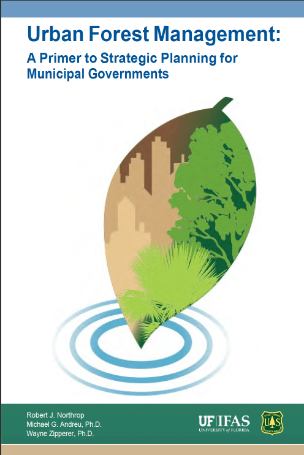
Urban Forest Management: A Primer to Strategic Planning for Municipal Governments.
by Robert J. Northrop, M.S, Michael G. Andreu, Ph.D., and Wayne Zipperer, Ph.D.
Urban planners and city administrators face daily challenges in managing complex urban environments, such as maintaining sufficient levels of clean water, clean air, energy, housing, and green spaces, as well as addressing conflicts of interest related to land use. More than ever, they must rise to the challenge of ensuring that their cities are economically, socially, and environmentally sustainable. Well-designed and managed urban forests are integral to meeting this challenge: urban forests can make significant contributions to the sustainable development, economic viability and livability of cities. In an urban environment, healthy and thriving trees, woodlands, and parks require careful planning, design, and management to achieve their full economic, social, and ecological potential.
A strategic plan for urban forest management identifies a series of practical and quantifiable steps that guide activities and resources to accomplish predetermined outcomes, the time frame for implementation, and the responsible agency or partnership. By establishing clear lines of responsibility and measurable objectives tied to reasonable timelines, a city can measure successes and identify programmatic areas in need of further attention. The plan itself is best seen as a long-term process, a living and adaptable plan of action, and not a static product.
The purpose of this book titled: Urban Forest Management: A Primer to Strategic Planning for Municipal Governments is to assist in the organization of a strategic plan for urban forest management. This guide was written specifically for use by people responsible for the initiation, or redesign, an urban forest management program. The methodology is flexible, adaptable and appropriate for town, city, county and state urban forest management program development. It was initially developed for use in the State of Florida but this framework can be applied universally.
Our experience suggests that in the current environment, urban forest management tends to involve short-term decision-making reacting to immediate needs (safety, tree hazards, etc.), principally driven by rapid land-use change and local economic concerns.It tends to address the symptoms of the problem rather than the problem itself (reactive vs. proactive). As a result, decisions and actions are often redundant, inefficient, and sometimes have to be completely redone as other priorities are identified later. What is needed is a longer-term perspective that puts forest management within the broader context of the city’s infrastructure and does not leave it as an afterthought.
An effective and sustainable urban forest management program must address three major components: social systems, governance systems, and the ecological systems. The social component provides the justification for the plan by demonstrating value to the people that live and utilize the forest. The governance component provides guidance to responsible entities on how, when and where management activities will occur. The ecological component addresses the dynamic nature of the system, which is the reason this process is different than simply managing other infrastructure such as transportation systems, sewer systems or electrical grids. As you might expect, the social and governance components add a level of complexity to the planning process not often encountered when developing an urban forest management program. Ideally these three components are integrated throughout the plan to inform government department procedures, policies, and other activities.
This guide will lead you through a series of steps to develop a long-range strategic plan that will:
- Identify the perceptions and values of the citizens;
- Create a citizen-based vision for the urban forest;
- Identify broad qualitative goals that define the vision;
- Draw up guiding principles that define the limits of government purpose and action;
- Identify quantifiable management objectives;
- Implement plans (short range)
- Develop annual work plans; and
- Monitor implementation and effectiveness.
There are five sections in this guide:
- the conceptual framework,
- plan initiation and engagement,
- plan development,
- plan re-engagement and adoption, and
- plan implementation and accountability.
For each implementation step, we provide the what, who, how, and why. In addition, we indicate specific appendices with information on various techniques, methodologies and examples, as well as an annotated bibliography. Click here to download a free copy: URBAN FOREST MANAGEMENT BOOK
